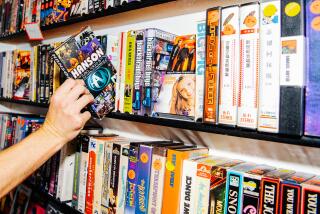Unresolved Issues Slow Digital Recording
As the transition from analog to digital TV grinds along, one key piece remains stubbornly out of place: a digital successor to the VCR.
The federal government mandated the shift to digital in 1997, enabling broadcasters to offer the richly detailed, wide-screen format called high-definition TV. But as a side effect, consumers are being forced to replace at least some of their video gear with digital versions.
For starters, anyone who wants to experience HDTV needs a digital set. HDTV offers more than 10 times as much detail as analog TV, which is far more than a conventional set can display.
Nor can a conventional VCR capture or transmit an HDTV signal. And the current line of personal video recorders, which use built-in hard drives instead of removable tapes, aren’t equipped to receive HDTV.
Consumer electronics companies have put a handful of HDTV-capable digital videotape recorders on the market, and four Hollywood studios recently announced that they’ll release HDTV videotapes that will work in some of these D-VHS machines. But those devices can’t record off the vast majority of today’s digital TVs and receivers.
That’s because these sets don’t have digital inputs or outputs. And as it turns out, digital connectors are proving to be a vital link in the HDTV recording chain.
Consider this another growing pain for digital TV, which has endured high prices, battles over standards, antenna disputes and a shortage of programming. The migration from analog is well underway, but unresolved issues continue to slow the transition to digital and threaten consumers who make the investment in costly HDTV sets.
There wasn’t much demand for HDTV recorders in previous years, mainly because there wasn’t much to record. Today, however, CBS, ABC, HDNet, HBO and some pay-per-view services are offering high-definition programs daily.
Here’s the technical challenge for HDTV recording. A digital TV signal is a stream of data representing millions of tiny points of color. In its raw form, HDTV consumes up to 1.8 billion bits of data per second. At that rate you’d need more than 800 gigabytes of storage to record a single one-hour program, or about seven times as much capacity as the largest personal video recorder provides.
Broadcasters don’t transmit raw digital signals, however. They compress them, cutting the data stream to less than 20 million bits per second. A digital receiver then unpacks the data and sends it to the screen in uncompressed form.
Japanese consumer electronics giant JVC, the inventor of the VHS format, solved the recording challenge by developing a digital VCR that stores compressed HDTV signals. These D-VHS machines can either unpack the data themselves, or send the compressed data digitally to a TV.
The main problem is that the U.S. models can’t tune in a compressed HDTV signal for themselves. They rely on a digital TV or set-top receiver to do it for them. And few of the TVs or receivers on the market have a FireWire output, the digital connector needed to pass a compressed signal on to a D-VHS recorder.
Forthcoming models of satellite and cable boxes are expected to provide those connectors, but that raises another issue. One of the two companies selling D-VHS machines in the U.S. is Mitsubishi, and its D-VHS machines use FireWire outputs as well as inputs. So they’ll only work with HDTVs that have FireWire inputs, which limits the field to half a dozen new Mitsubishi and Sony models.
JVC’s D-VHS machines have conventional analog outputs as well as FireWire. However, the Hollywood studios are pressing JVC and other manufacturers to phase out analog connectors in favor of digital ones, which provide greater protection against piracy. At the same time, some studios are demanding copy-protection technology that lets them block a high-definition tape from being played through analog connectors.
The compatibility issues will disappear when and if manufacturers settle on a common digital connector. By then, though, there’s likely to be a disc-based recorder for HDTV, which could sound the death knell for D-VHS.
*
Jon Healey covers the convergence of entertainment and technology. He can be reached at jon.healey @latimes.com.
More to Read
The biggest entertainment stories
Get our big stories about Hollywood, film, television, music, arts, culture and more right in your inbox as soon as they publish.
You may occasionally receive promotional content from the Los Angeles Times.









